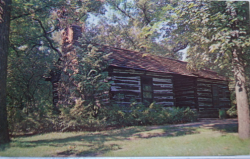Encyclopedia Dubuque
"Encyclopedia Dubuque is the online authority for all things Dubuque, written by the people who know the city best.”
Marshall Cohen—researcher and producer, CNN
Affiliated with the Local History Network of the State Historical Society of Iowa, and the Iowa Museum Association.
LOG CABIN: Difference between revisions
No edit summary |
No edit summary |
||
| Line 11: | Line 11: | ||
The building was moved to [[EAGLE POINT PARK]]. In 1949-50 the Park Board voted to remodel the cabin replacing rotted logs, windows and doors. A new shingle roof was added and the wood was treated with a preservative. (26) The total cost was $5,000. In 1957 it was recognized by the Dubuque Chapter of the Daughters of the American Revolution who marked it with a bronze plaque. | The building was moved to [[EAGLE POINT PARK]]. In 1949-50 the Park Board voted to remodel the cabin replacing rotted logs, windows and doors. A new shingle roof was added and the wood was treated with a preservative. (26) The total cost was $5,000. In 1957 it was recognized by the Dubuque Chapter of the Daughters of the American Revolution who marked it with a bronze plaque. | ||
In 1963 a proposal was made to renovate the cabin and put it off limits as a pavilion. The exterior would be restored to its 1820s appearance and the interior would be provided with pioneer furnishings. The doorway would be covered with glass so that the interior could be viewed. Security would be provided by spotlights positioned outside. ( | In 1963 a proposal was made to renovate the cabin and put it off limits as a pavilion. The exterior would be restored to its 1820s appearance and the interior would be provided with pioneer furnishings. The doorway would be covered with glass so that the interior could be viewed. Security would be provided by spotlights positioned outside. (5) This was never done. The building was moved to the grounds of the Ham House in 1967. | ||
| Line 25: | Line 25: | ||
4. Ibid., p. 57 | 4. Ibid., p. 57 | ||
5. Thompson, Dave. "Park Board Cool to Log Cabin Plan," ''Telegraph Herald'', March 11, 1963, p. 32. Online: http://news.google.com/newspapers?id=bhJRAAAAIBAJ&sjid=I8sMAAAAIBAJ&pg=5880,1380607&dq=history+of+eagle+point+park+dubuque&hl=en | |||
[[Category: Architecture]] | [[Category: Architecture]] | ||
Revision as of 02:32, 6 March 2017
LOG CABIN. (Louis Arrandeaux/Wlliam Newman Log House) Now located at the HAM HOUSE Museum, the cabin is believed to be the oldest building in Iowa. Constructed in 1827, the cabin stood at Second and Locust STREETS. (1)
The cabin was built, according to best records, by Louis Arrandeaux, a miner believed married to a daughter of Chief Blackhawk. A barber, Samuel Ellmer, later lived in the cabin and used his mastery of ventriloquism to convince Native Americans in the area that he had magical powers. The building, therefore, became a place of shelter for whites who knew they were safe from attack. (2)
The cabin was constructed in a form called dogtrot. The style developed in Sweden, Germany, Finland and Russia centuries before it appeared in Dubuque. In most, the kitchen, dining room and living room existed in one portion. The other portion served as a bedroom. Each part had its own fireplace. Theories exist that the breezeway between the two parts was to provide good airflow. (3) Given the cold regions in which it was developed, however, it may just as well have given inhabitants an opportunity to escape cooking odors.
In 1834 William Newman purchased the cabin and lived in it with his guardian, Mary Smith, after her parents died of CHOLERA. Years later, he offered Augustin A. COOPER, his apprentice, the opportunity of living in the half of the cabin containing the kitchen. At the age of twenty-two, Cooper married Mary Smith on the threshold of the cabin with Bishop Mathias LORAS officiating. (4)
Clapboards painted white were eventually nailed to the cabin and disguised it until 1915 when it was discovered by Frederick Ezekiel BISSELL.
The building was moved to EAGLE POINT PARK. In 1949-50 the Park Board voted to remodel the cabin replacing rotted logs, windows and doors. A new shingle roof was added and the wood was treated with a preservative. (26) The total cost was $5,000. In 1957 it was recognized by the Dubuque Chapter of the Daughters of the American Revolution who marked it with a bronze plaque.
In 1963 a proposal was made to renovate the cabin and put it off limits as a pavilion. The exterior would be restored to its 1820s appearance and the interior would be provided with pioneer furnishings. The doorway would be covered with glass so that the interior could be viewed. Security would be provided by spotlights positioned outside. (5) This was never done. The building was moved to the grounds of the Ham House in 1967.
---
Source:
1. Larry FRIEDMAN and Katherine FISCHER, A. A. Cooper: Reinvesting the Wheel, River City Press, 2016, p. 42
2. Ibid.
3. Ibid.
4. Ibid., p. 57
5. Thompson, Dave. "Park Board Cool to Log Cabin Plan," Telegraph Herald, March 11, 1963, p. 32. Online: http://news.google.com/newspapers?id=bhJRAAAAIBAJ&sjid=I8sMAAAAIBAJ&pg=5880,1380607&dq=history+of+eagle+point+park+dubuque&hl=en



